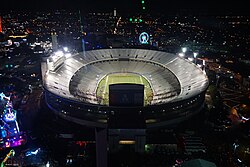"The House That Doak Built" | |
 | |
 | |
| Former names | Fair Park Stadium (1930–1936) |
|---|---|
| Address | 1300 Robert Cullum Blvd. |
| Location | Dallas, Texas |
| Coordinates | 32°46′46″N 96°45′35″W / 32.77944°N 96.75972°W |
| Owner | City of Dallas |
| Capacity | 92,100[2] |
| Record attendance | 96,009[3] (thrice) |
| Surface | Natural grass (1930–1969, since 1994) AstroTurf (1970–1993) |
| Construction | |
| Broke ground | 1930[1] |
| Opened | 1930, 94 years ago |
| Renovated | 1936, 1968, 1993, 2008 |
| Expanded | 1948–1949, 1993, 2008 |
| Construction cost | $328,200 ($5.99 million in 2023[4]) |
| Architect | Mark Lemmon, 1930 George Dahl, 1936 Hellmuth, Obata & Kassabaum, 1993 |
| Structural engineer | Chappell, Stokes & Brenneke, 1948–1949 |
| Tenants | |
| |
| Website | |
| Official website | |
The Cotton Bowl | |
| Architectural style | Art Deco |
| Part of | Texas Centennial Exposition Buildings (1936–1937) (ID86003488[5]) |
| TSAL No. | 8200000209 |
| DLMKHD No. | H/33 (Fair Park) |
| Significant dates | |
| Designated CP | September 24, 1986 |
| Designated TSAL | January 1, 1984 |
| Designated DLMKHD | March 4, 1987[6] |
The Cotton Bowl is an outdoor stadium in Dallas, Texas, United States. Opened in 1930 as Fair Park Stadium, it is on the site of the State Fair of Texas, known as Fair Park.
The Cotton Bowl was the longtime home of the annual college football post-season bowl game known as the Cotton Bowl Classic, after which the stadium is named. Starting on New Year's Day 1937, it hosted the first 73 editions of the game, through January 2009; the game was moved to AT&T Stadium in Arlington in January 2010. The stadium also hosts the Red River Rivalry, the annual college football game between the Oklahoma Sooners and the Texas Longhorns, and formerly, the First Responder Bowl.
The stadium has been home to many football teams over the years, including: SMU Mustangs (NCAA), Dallas Cowboys (NFL; 1960–1971), Dallas Texans (NFL) (1952), Dallas Texans (AFL; 1960–1962), and soccer teams, the Dallas Tornado (NASL; 1967–1968), and FC Dallas (MLS; as the Dallas Burn 1996–2004, as FC Dallas 2005). It was also one of the nine venues used for the 1994 FIFA World Cup. As of 2022, it is the largest stadium by capacity in the United States without a professional or college team as a regular tenant.
It became known as "The House That Doak Built," due to the immense crowds that SMU running back Doak Walker drew to the stadium during his college career in the late 1940s.[7]
In their seventh season, the Cowboys hosted the Green Bay Packers for the NFL championship at the Cotton Bowl on January 1, 1967.[8][9] The college bowl game that year included SMU and was played the day before, New Year's Eve, which required a quick turnaround to transform the field.[10] The two games were filled to its 75,504 capacity, but both home teams lost to the visitors.
Artificial turf was installed in 1970 and removed in 1993 in preparation for the 1994 FIFA World Cup. The elevation of the playing field is approximately 450 feet (140 m) above sea level.
- ^ "Welcome to the City of Dallas, Texas – Fair Park, Tx. One fun thing leads to another". City of Dallas. June 2, 2001. Archived from the original on July 1, 2007. Retrieved October 10, 2015.
- ^ "College Football–State Fair of Texas". State Fair of Texas. October 10, 2015. Retrieved October 10, 2015.
- ^ "Oklahoma Sooners vs. Texas Longhorns – Recap – October 17, 2009". ESPN. October 17, 2009. Archived from the original on October 20, 2009. Retrieved October 20, 2012.
- ^ 1634–1699: McCusker, J. J. (1997). How Much Is That in Real Money? A Historical Price Index for Use as a Deflator of Money Values in the Economy of the United States: Addenda et Corrigenda (PDF). American Antiquarian Society. 1700–1799: McCusker, J. J. (1992). How Much Is That in Real Money? A Historical Price Index for Use as a Deflator of Money Values in the Economy of the United States (PDF). American Antiquarian Society. 1800–present: Federal Reserve Bank of Minneapolis. "Consumer Price Index (estimate) 1800–". Retrieved February 29, 2024.
- ^ "National Register Information System". National Register of Historic Places. National Park Service. November 2, 2013.
- ^ "Ordinance No. 27079" (PDF). City of Dallas. 2008. Retrieved August 16, 2018.
- ^ Weller, Robert (September 28, 1998). "His college's only Heisman winner; played for Detroit Lions". Pittsburgh Post-Gazette. Associated Press. p. A14.
- ^ Johnson, Chuck (January 1, 1967). "Today's the day – Packers vs. Dallas". Milwaukee Journal. p. 1, sports.
- ^ Lea, Bud (January 2, 1967). "Packers tip Dallas for title, 34–27". Milwaukee Sentinel. p. 1, part 2.
- ^ "Georgia grinds out 24–9 Cotton victory". Milwaukee Journal. January 1, 1967. p. 1, sports.